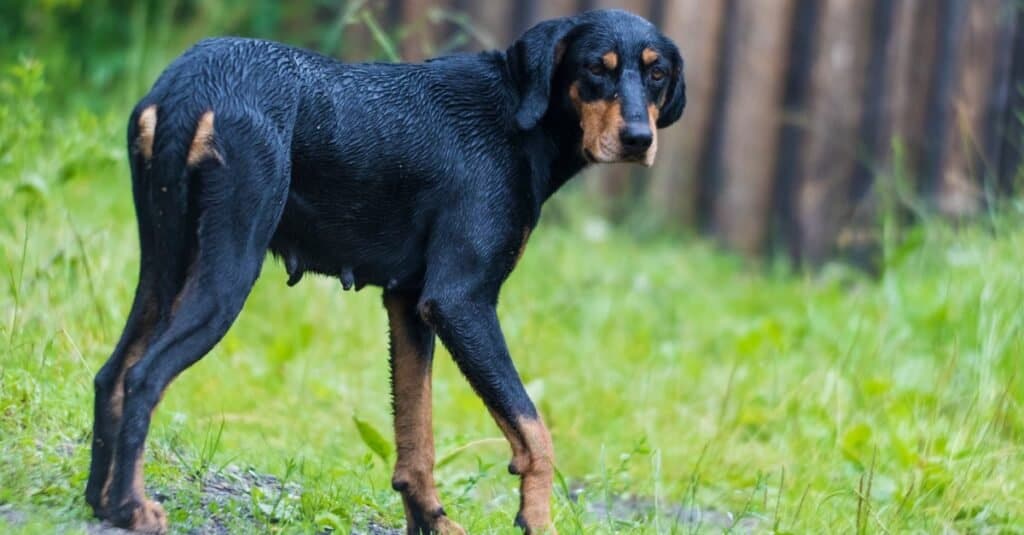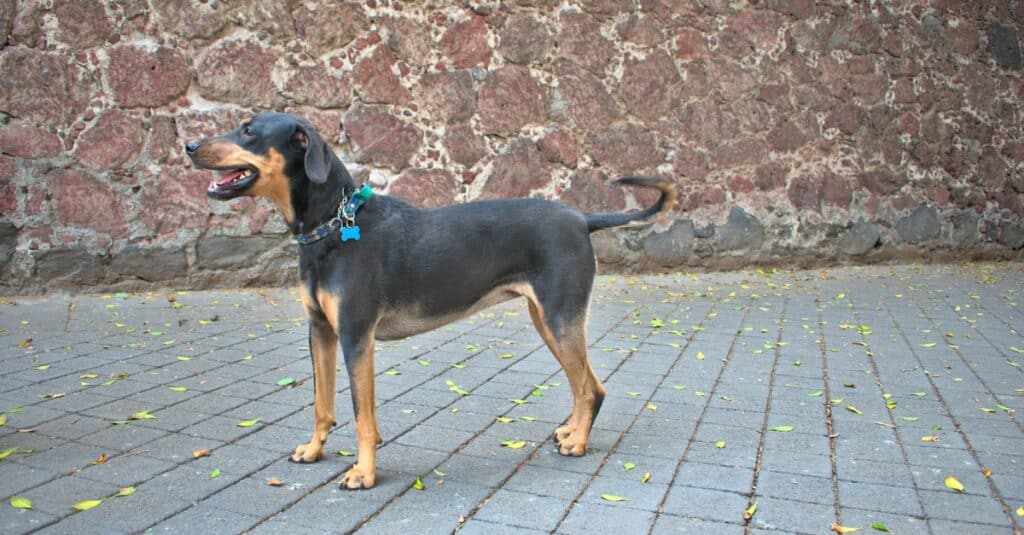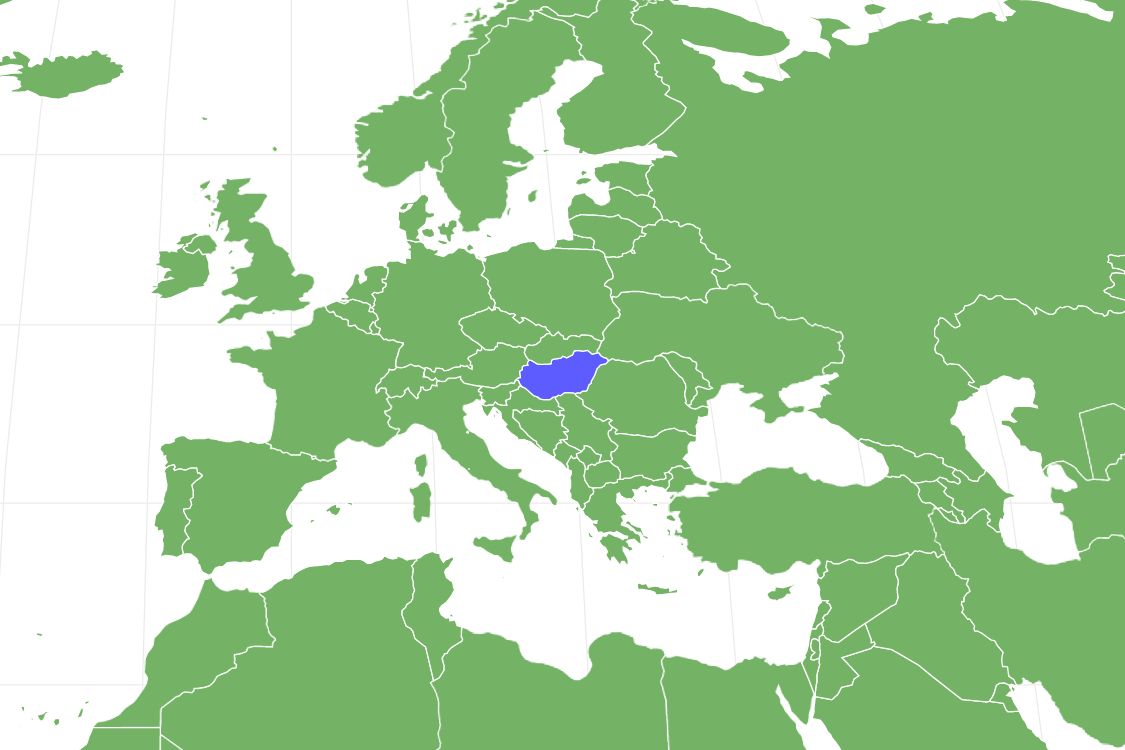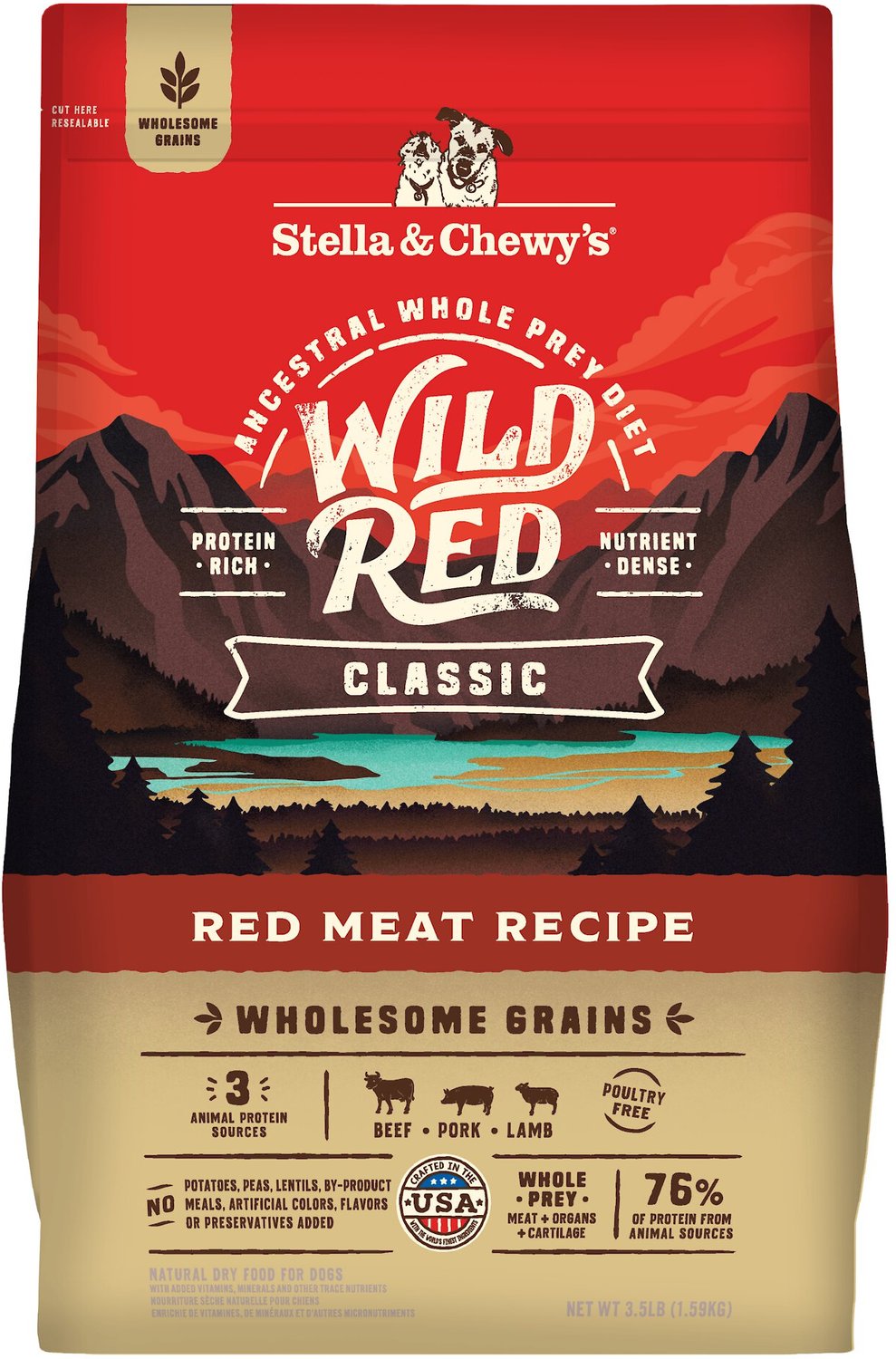Transylvanian Hound
Canis lupus
The Transylvanian Hound is also known as the Erdelyi Kopo in Hungarian
Advertisement
Transylvanian Hound Facts
- Fun Fact
- The Transylvanian Hound is also known as the Erdelyi Kopo in Hungarian
- Temperament
- Even-tempered, fearless, and relentless
- Diet
- Omnivore
Transylvanian Hound as a Pet:
- General Health
- Energy Level
- Shedability
- Trainability
- Intelligence
- Tendency to Chew
- Size
- Family and kid friendliness
- Yappiness / Barking
- High
- Separation Anxiety
- High
- Preferred Temperature
- Average climate
- Exercise Needs
- High
- Friendly With Other Dogs
- High
- Pure bred cost to own
- $1,000 to $1,500 on average
- Dog group
- Hound
- Male weight
- 55-77 lbs
- Female weight
- 55-77 lbs
This post may contain affiliate links to our partners like Chewy, Amazon, and others. Purchasing through these helps us further the A-Z Animals mission to educate about the world's species.
View all of the Transylvanian Hound images!
The Transylvanian Hound once came in two different sizes: short-legged and long-legged. The short-legged has historically hunted small game such as foxes and hares in rocky or overgrown terrain. The long-legged version hunted big game such as bears, bison, boar, and lynxes in woodlands and grasslands.
The Transylvanian Hound is a very old breed of hunting dog, dating back over 1,000 years. It’s believed that they were originally brought to the region by the Magyars, a nomadic people who settled west of the Transylvanian Mountains and founded the first Hungarian state. In the Middle Ages, back when Transylvania was still part of Hungary, this breed was highly prized by the Hungarian aristocracy for its hunting prowess and discipline. However, the combined effects of war and political turmoil in the 20th century nearly conspired to drive this breed toward extinction. Its fortunes were later revived thanks to the hard work of some Hungarian and Slovakian breeders, but this breed remains relatively rare and difficult to find outside of its native home.
See all of our expert product reviews.
The Transylvania Hound was specially adapted for the climate and terrain of Hungary. It is characterized by an athletic body, a long tail, big muzzle, drooping ears, and a short coat with black and tan or a tri-color appearance. It also has a remarkable sense of smell and a nonstop motor. While it was primarily bred as a hunter, this pack dog also makes for a great companion in the home.

Transylvanian Hound Vs. Doberman
The Transylvania Hound and the Doberman may look remarkably similar to each other on account of their size, coat color and consistency, and general appearance. However, the Doberman is more of a working dog with a distinctive history. In 19th century Germany, this breed accompanied the taxman to ensure that the people paid up. It was not used for hunting at all. It was more of a protective guard dog.
3 Pros And Cons Of Owning A Transylvania Hound
| Pros! | Cons! |
|---|---|
| Super Affectionate and Good-Natured The Transylvania Hound loves to spend time with people and pets. | High Mental and Physical Needs This breed is a constant whirlwind of activity. Casual owners might struggle to keep up with it. |
| Intelligent and Eager to Please This breed is eager to learn new things. | Strong Prey Drive The Transylvania Hound has a tendency to chase after smaller animals |
| Playful and Energetic This breed is great for owners who want a playful exercise companion. | Highly Vocal This breed vocalizes often to express itself. |

.
©Mircea Costina/Shutterstock.com
Size And Weight
The Transylvania Hound is a medium-sized, athletic dog with balanced movement and (as some people have described it) a noble and elegant bearing. Historically this breed has come in two different sizes, but it’s now believed that the short-legged version (which stands 18 to 20 inches) is extinct.
Health and Entertainment for your Transylvanian Hound
See all of our expert product reviews.
| Height (Male) | 22 to 26 inches |
| Height (Female) | 22 to 26 inches |
| Weight (Male) | 55 to 77 pounds |
| Weight (Female) | 55 to 77 pounds |
Types Of
While there is only one type of Transylvania Hound, there are two different types of sizes variants that they come in. The short-legged variety (which is believed to no longer be in existence) and the long-legged variety. The Fédération Cynologique International (FCI), or International Canine Federation, breed standard only describes the long-legged variety.
Common Health Issues
The Transylvania Hound is a very healthy breed; this is reflected in its average lifespan of 10 to 14 years. It is susceptible to both hip and elbow dysplasia, in which the joint will sometimes slip loose from its socket, causing pain and lameness, but any good, trusted breeder should screen their dogs for joint problems before they’re given a home. There is also a chance that this breed could develop cancer and heart problems, especially later in life. Regular appointments at the vet should help to catch health problems early before they become serious. In summation, these are the most common health conditions with the Transylvania Hound:
- Hip and elbow dysplasia
- Cancer
- Heart problems
Temperament

A Transylvanian hound has high energy levels and requires a lot of mental stimulation.
©Hanna Taniukevich/Shutterstock.com
The Transylvania Hound has many appealing personality traits; it is fearless, determined, playful, intelligent, and super affectionate, and protective with the family, yet also highly open to strangers and unfamiliar faces. It has remarkable energy levels and mental stimulation needs, so be prepared to spend a lot of time with this dog, engaged in many of its activities. If it becomes bored, you may face a torrent of destruction and bad behavior.
How To Take Care Of The Transylvanian Hound
The Transylvanian Hound is not necessarily recommended for novice or casual owners. While it isn’t too difficult to care for, this breed does require plenty of companionship, playtime, exercise, and other activities. It can adapt fairly well to apartment living assuming you have enough space nearby to satisfy its exercise needs.
The Best Dog Food For Transylvanian Hounds
The Transylvania Hound will need a few cups of high-quality dog food per day, based on its size, age, and activity level. Either commercially available or homemade food is okay for a dog of this type. Stay away from any dog food containing legumes, since legumes are linked with heart failure in dogs.
A-Z Animals says the best dog food for Transylvanian Hounds is Stella & Chewy’s Wild Red Classic Kibble Dry Dog Food.
81% of this legume-free recipe’s protein comes from animals sources. A combination of turkey, duck, and chicken provide naturally-occurring glucosamine and chondroitin to keep your dog’s joints moving and free from pain. Importantly, this food includes taurine, which is excellent for their hearts.
Click this link to buy Stella and Chewy’s Wild Red Classic Kibble on Chewy and Amazon.
- Packed full of protein with beef, pork, and lamb
- Crafted without legumes or poultry
- 81% of protein is from actual animal sources
- "Whole prey” ingredients including muscle meat, organ meat, and cartilage
- No fillers, artificial colors, artificial flavors, or preservatives.
Maintenance And Grooming
The Transylvania Hound has a short coat that requires no special care. It should be sufficient to brush it once a week with a strong bristle blade and then remove loose fur with a rubber glove. The toenails do grow quickly, however, and need to be trimmed regularly to prevent them from cracking or clicking on the floor. This dog also requires frequent attention to its hygiene. If your dog begins to show signs of ear infections, then you should clean it out with a simple cotton swab and cleaning solution. Brush the teeth regularly as well to prevent disease and bad breath.
Training

Transylvanian hounds may not be the easiest dogs to train but they are eager to please.
©Nannupa/Shutterstock.com
The Transylvania Hound is eager to please and quick to grasp commands, but that does not necessarily mean it’s the easiest dog to train. As a hound, it has very strong hunting instincts and might have its own ideas about how it wants to do things. Patience, consistency, and clarity are required to get the most out of this breed. You should not push the dog too hard for too long, or it might reject your training altogether. You should let the dog learn at its own pace.
Exercise
The Transylvania Hound requires at least an hour of exercise every day. Long walks, fast-paced runs, fetching, and other forms of playtime should keep your dog healthy and occupied. This breed also excels at all forms of agility challenges and contests. Because of its strong prey drive, however, you might want to keep this dog on a leash when out in the open, even if it’s been well-trained.
Puppies

©Angyalosi Beata/Shutterstock.com
Your new Transylvanian puppy will need to undergo a rigorous process of socialization and training as soon as possible. Owners should not expect to train out their hunting instincts, but some bad behavior associated with their instincts might be minimized or curbed. While these are naturally friendly and affectionate dogs, the puppy still should be socialized early and often. Any place with lots of other people and dogs should work well, including parks, daycare, and playdates. This needs to be done in conjunction with teaching proper etiquette and manners. Crate training, while not mandatory, can help to solve housebreaking and behavioral issues.
The Transylvanian Hound And Children
The Transylvanian Hound is exceptionally affectionate and loyal toward children of all ages. Interactions between dogs and younger children should always be supervised by an adult, but a well-trained member of this breed is respectful and gentle around kids.
Dogs Similar To The Transylvanian Hound
The Transylvania Hound bears a strong resemblance to several other types of hunting dogs.
- Wirehaired Vizsla: This is a big Hungarian hunting dog with an even temperament and gentle demeanor. It is characterized by a dense, wiry coat and a harsh beard of golden sand-colored hair. It is a hard worker and an excellent companion.
- American Foxhound: Originally bred to track down foxes, this large hunting dog is easy-going, even-tempered, and independent-minded, although perhaps a little more reserved than the Transylvanian. It has a short but hard coat with black, tan, white, and even blue colored markings.
- Beagle: While it’s much smaller than the Transylvanian, the Beagle has a similar lovable, curious, and playful personality. It is one of the best-known scent hounds in the world.
Famous Transylvanian Hound Dogs
The Transylvanian Hound is relatively unknown outside of its native Hungary. There are few famous examples of this breed.
Popular Names For The Transylvanian Hound
If you’re still unsure about what to name your new dog, then you might want to consider one of the following options:
- Buddy
- Duke
- Copper
- Hunter
- Dexter
- Lily
- Roxie
- Sadie
- Archie
- Mac
Transylvanian Hound FAQs (Frequently Asked Questions)
How rare is the Transylvanian Hound?
The Transylvanian Hound is especially rare outside of Hungary. It might be difficult to find without a thorough search. Your best bet is to get in touch with a breed-specific program or rescue. This breed is listed with the American Kennel Club in its foundation stock service, which provides assistance for prospective breeds seeking full recognition.
How big do Transylvanian hounds get?
The Transylvania Hound normally grows no longer than 26 inches at the shoulders and up to 77 pounds.
How much does a Transylvanian Hound cost?
The price of a Transylvania Hound depends on many factors, including the pedigree, the health of the dog, and the availability in your area. You should expect to pay at least $1,000 for a new puppy. While this price may seem expensive, it also ensures the dog is bred from good stock and given a thorough health evaluation. It might be possible to find one for less, especially if you plan to adopt a dog. The price of adoption is usually somewhere around $300 or less. Unfortunately, because of their rarity, it’s unlikely that this breed will be easy to find in general kennels and rescue shelters.
Are Transylvanian Hounds good dogs?
That depends on your definition of a good dog, but they are very affectionate, smart, playful, even-tempered companions that get along well with just about everyone. The major downside is that they do require a lot of time from the owner to satisfy their need for exercise and mental stimulation. Its strong hunting instincts may sometimes take over and get it into trouble.
What breeds make a Transylvanian Hound?
The Transylvania Hound is only composed of a single breed.
How smart are Transylvanian Hounds?
The Transylvania Hound ranks very highly in its intelligence. In order to really maximize the breed’s quality of life, it’s a good idea to take advantage of its excellent learning and problem-solving abilities with toys, challenges, trials, activities, and games.
How long do Transylvanian hounds live?
The Transylvania Hound has an average lifespan of 10 to 14 years, but with enough good luck and care, it can potentially live several years longer.
Thank you for reading! Have some feedback for us? Contact the AZ Animals editorial team.
Sources
- American Kennel Club, Available here: https://www.akc.org/dog-breeds/transylvanian-hound/
- Dog Zone, Available here: https://www.dogzone.com/breeds/transylvanian-hound/


















